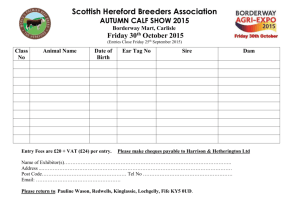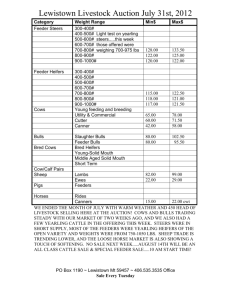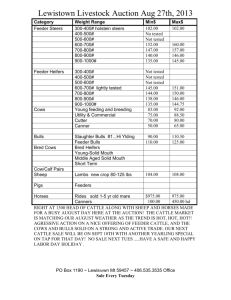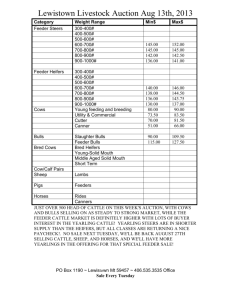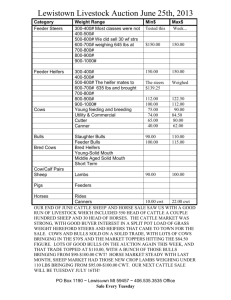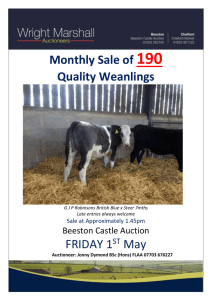Paper - didgeridoo - University of New England
advertisement
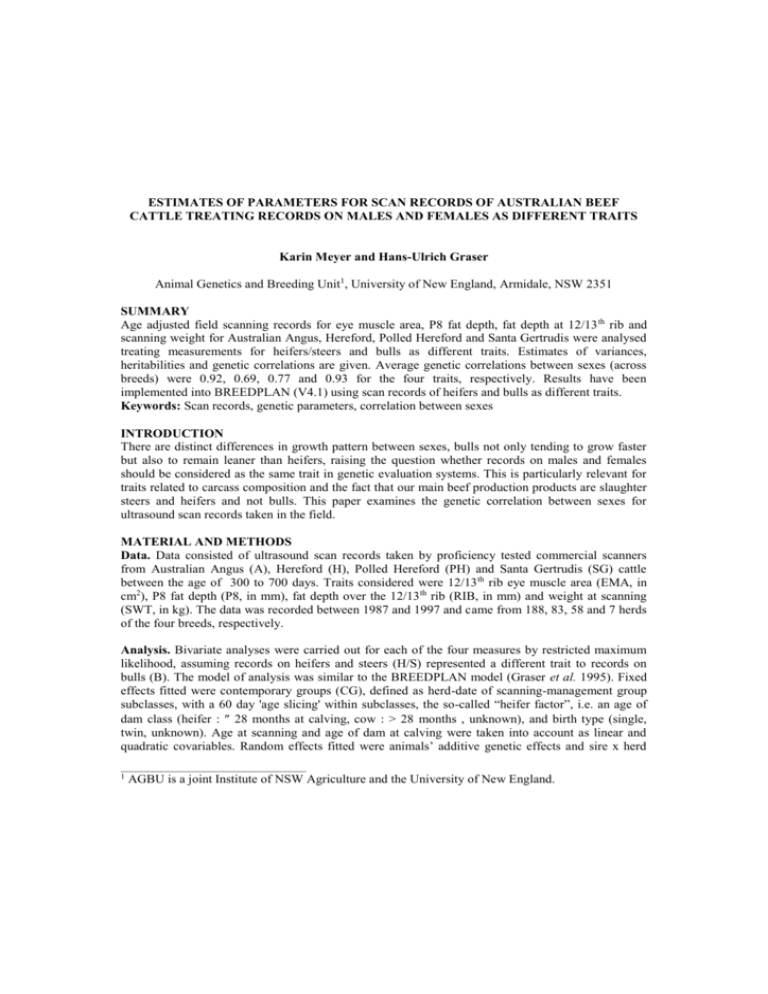
ESTIMATES OF PARAMETERS FOR SCAN RECORDS OF AUSTRALIAN BEEF CATTLE TREATING RECORDS ON MALES AND FEMALES AS DIFFERENT TRAITS Karin Meyer and Hans-Ulrich Graser Animal Genetics and Breeding Unit1, University of New England, Armidale, NSW 2351 SUMMARY Age adjusted field scanning records for eye muscle area, P8 fat depth, fat depth at 12/13 th rib and scanning weight for Australian Angus, Hereford, Polled Hereford and Santa Gertrudis were analysed treating measurements for heifers/steers and bulls as different traits. Estimates of variances, heritabilities and genetic correlations are given. Average genetic correlations between sexes (across breeds) were 0.92, 0.69, 0.77 and 0.93 for the four traits, respectively. Results have been implemented into BREEDPLAN (V4.1) using scan records of heifers and bulls as different traits. Keywords: Scan records, genetic parameters, correlation between sexes INTRODUCTION There are distinct differences in growth pattern between sexes, bulls not only tending to grow faster but also to remain leaner than heifers, raising the question whether records on males and females should be considered as the same trait in genetic evaluation systems. This is particularly relevant for traits related to carcass composition and the fact that our main beef production products are slaughter steers and heifers and not bulls. This paper examines the genetic correlation between sexes for ultrasound scan records taken in the field. MATERIAL AND METHODS Data. Data consisted of ultrasound scan records taken by proficiency tested commercial scanners from Australian Angus (A), Hereford (H), Polled Hereford (PH) and Santa Gertrudis (SG) cattle between the age of 300 to 700 days. Traits considered were 12/13 th rib eye muscle area (EMA, in cm2), P8 fat depth (P8, in mm), fat depth over the 12/13 th rib (RIB, in mm) and weight at scanning (SWT, in kg). The data was recorded between 1987 and 1997 and came from 188, 83, 58 and 7 herds of the four breeds, respectively. Analysis. Bivariate analyses were carried out for each of the four measures by restricted maximum likelihood, assuming records on heifers and steers (H/S) represented a different trait to records on bulls (B). The model of analysis was similar to the BREEDPLAN model (Graser et al. 1995). Fixed effects fitted were contemporary groups (CG), defined as herd-date of scanning-management group subclasses, with a 60 day 'age slicing' within subclasses, the so-called “heifer factor”, i.e. an age of dam class (heifer : 28 months at calving, cow : > 28 months , unknown), and birth type (single, twin, unknown). Age at scanning and age of dam at calving were taken into account as linear and quadratic covariables. Random effects fitted were animals’ additive genetic effects and sire x herd ____________________________________ 1 AGBU is a joint Institute of NSW Agriculture and the University of New England. interaction effects. Pedigree information up to two generations back was considered, while sire x herd effects were assumed to be independently distributed. RESULTS Characteristics of the data structure are summarised in Table 1. Means and standard deviations show clear differences between sexes, with bulls being heavier and having correspondingly larger EMA but being leaner and showing considerably less variation in fat depth than heifers and steers. Table 1 : Characteristics of the data structure EMA H/S RIB B H/S B Angus No. records 14,124 18,583 14,056 18,523 14,128 18,602 Mean 54.85 75.07 5.772 4.209 4.412 3.236 SD 9.73 13.78 3.435 2.364 2.526 1.671 Mean age 495.8 503.9 496.3 504.2 495.8 503.8 No. CGA 1189 1751 1187 1755 1187 1755 No. animalsB 64,606 64,441 64,644 No. SxHC 3321 3323 3333 Hereford No. records 10,499 15,064 10,536 15,069 10,537 15,071 Mean 51.90 74.11 6.111 4.616 3.938 3.180 SD 9.76 13.71 3.820 2.686 2.116 1.535 Mean age 514.2 527.7 514.1 527.7 514.1 527.7 No. CG 936 1618 940 1625 940 1625 No. animals 47,087 47,159 47,170 No. SxH 2446 2457 2457 Polled Hereford No. records 4385 4824 4377 4790 4384 4807 Mean 52.20 74.58 5.797 5.053 3.940 3.451 SD 10.25 12.91 3.337 2.848 2.018 1.679 Mean age 504.9 515.4 504.9 515.3 505.0 515.3 No. CG 488 701 487 699 487 700 No. animals 20,466 20,432 20,451 No. SxH 1042 1043 1043 Santa Gertrudis No. records 3165 3547 3260 3598 3255 3597 Mean 55.06 68.98 5.29 2.59 3.30 1.88 SD 10.56 12.87 3.55 2.07 1.99 1.16 Mean age 528.0 530.2 522.2 526.9 522.1 527.0 No. CG 196 225 210 239 211 238 No. animals 11,203 11,131 11,112 No. SxH 684 700 699 A B Contemporary Groups, In the analysis, including parents without records C Sire x herd interaction effects B P8 H/S SWT H/S B 14,004 18,222 369.3 500.0 73.7 102.3 495.2 502.8 1175 1720 63,463 3287 10,374 14,761 367.54 516.36 69.35 103.32 514.9 528.2 919 1580 46,349 2404 4354 4822 356.9 514.0 63.0 101.8 504.8 515.5 483 697 20,430 1042 3316 3662 360.1 440.0 83.8 98.7 521.5 525.4 216 243 11,543 703 Estimates of phenotypic variances (P2), heritabilities (h2), the variance due to sire x herd effects expressed as a proportion of P2 (s2), and the corresponding correlations between sexes, r G and rS, respectively, are given in Table 2 and corresponding estimates of regression coefficients are summarised in Table 3. Note that with traits measured on distinct subsets of animals, residual covariances are zero, i.e. there is no phenotypic correlation in the usual sense. Distinct differences in P2 between sexes and breeds could largely be attributed to scale effects. While coefficients of variations tended to be highest for SG, they were very similar for B and H/S for fat measures (3246%) and only slightly higher for H/S (8-11%) than B (7-9%) for EMA and SWT. For fat depths, h2 for H/S were consistently higher than for B, presumably because higher fat levels in H/S allowed better expression of genetic variation. Estimates for s2 were consistently low, but significant in the two larger data files, ranging from 0 to 0.05. Table 2. EstimatesA from bivariate analyses of scan traits, treating measurements on heifers and steers (H/S) and bulls (B) as different traits Sex P2 h2 s2 rG rS P2 h2 s2 rG rS EMA H/S B 27.75 44.55 0.27 0.27 0.03 0.03 0.89 1.00 32.1 0.32 0.02 0.91 0.60 48.4 0.22 0.03 P2 h2 s2 rG rS 30.30 45.51 0.22 0.32 .02 0.00 0.88 1.00 P2 h2 s2 rG rS 25.47 35.72 0.35 0.13 0.01 0.04 1.00 0.92 P8 H/S RIB B H/S Angus 3.950 2.509 1.952 0.41 0.28 0.34 0.05 0.03 0.06 0.80 0.83 0.32 0.30 Hereford 4.662 2.765 1.562 0.31 0.24 0.25 0.02 0.03 0.02 0.87 0.79 0.37 0.34 Polled Hereford 3.806 2.998 1.521 0.44 0.32 0.28 0.01 0.73 0.80 -1.00 Santa Gertrudis 4.411 1.413 1.530 0.37 0.11 0.32 0.02 0.02 0.04 0.35 0.65 1.00 0.51 B SWT H/S B 1.142 0.23 0.05 831.7 1328.8 0.46 0.36 0.05 0.05 0.93 0.66 0.942 0.21 0.03 1003 0.39 0.04 0.89 0.38 1.076 0.23 0.00 881.3 1457.0 0.34 0.45 0.05 0.00 0.90 1.00 0.502 0.08 0.03 927.5 1453.6 0.28 0.15 0.03 0.01 1.00 0.77 1576 0.31 0.02 P2 : Phenotypic variance, h2 : heritability, s2 : sire x herd interaction effect (expressed as proportion of phenotypic variance), rG : genetic correlation, rS : correlation between sire x herd effects A Table 3. Estimates of linear (L) and quadratic (Q) regression coefficients (multiplied by 104) on dam age (DA, in years) and age at scanning (A, in days) EMA H/S DA A DA A DA A DA A B L Q L Q 2253.65 -335.76 629.23 -0.72 1484.59 -239.01 699.14 -0.88 L Q L Q 2489.18 -480.03 492.71 -0.78 2051.97 -372.13 675.65 -0.63 L Q L Q 3469.90 -587.53 660.42 -0.52 2265.14 -398.00 774.19 -1.09 L Q L Q 1058.79 -450.32 566.81 -0.29 30.72 -245.81 759.09 -0.25 P8 H/S RIB B H/S Angus 859.13 156.92 594.61 -114.03 -23.21 -94.35 198.06 94.55 128.45 0.10 -0.06 0.06 Hereford 989.71 391.97 654.89 -116.37 -43.11 -83.02 185.42 89.19 83.62 0.18 0.07 0.01 Polled Hereford 996.12 417.17 725.07 -126.29 -84.93 -99.79 209.61 65.03 134.12 0.05 -0.12 0.05 Santa Gertrudis 9.00 -22.67 156.15 -70.53 10.03 -59.47 167.67 38.64 98.49 0.16 -0.12 0.14 B SWT H/S B 93.91 20,614.6 20,804.8 -22.15 -4512.5 -4747.7 51.99 5513.9 7535.2 -0.03 -3.1 -4.4 228.99 17,502.3 22,855.5 -23.12 -3566.1 -5360.5 52.13 5146.7 7428.0 0.04 -19.9 -42.5 247.29 25100.0 -40.69 -4608.6 32.87 5303.8 -0.11 -6.2 31.20 -8.74 27.92 -0.06 7811.7 -461.5 5811.7 -3.9 31934.3 -6386.7 8344.3 -7.9 8741.2 -468.7 8311.5 -1.7 Estimates of rG for EMA and SWT were close to unity, averaging 0.92 and 0.93 respectively. Corresponding averages across breeds for P8 and RIB were 0.69 and 0.77, with lowest values found for SG, the breed with the lowest phenotypic fat averages and very low heritabilities for the two fat traits when recorded on bulls. In the literature only correlations between scan records on bulls or heifers and carcase data from steers are reported. Moser et al. (1998) found correlation of between 0.66 and 0.69 between the same traits by name recorded on the two different groups of animals. Estimates of the correlation between sire x herd effects (rS) were commonly lower than the genetic correlation between the sexes, however in some cases, low values of s 2 lead to spurious estimates of rS for the two smaller data sets.(e.g RIB in PH). Results indicate that accuracy of genetic evaluation can be improved by treating fat depth for males and females (+steers) as different traits this is now been done in BREEDPLAN. In addition, it should be ensured that males are scanned at a sufficient fat level, i.e. typically at older ages, to allow genetic variation in fatness to be expressed. REFERENCES Graser, H.-U. , Goddard, M.E. and Allen, J. (1995) Proc. Aust. Ass. Anim. Breed. Genet. 11 : 56 Moser, D.W., Bertrand, J.K., Misztal, I., Kriese, L.A. and Benyshek, L.L. (1998) J. Anim. Sci. 76:2542
